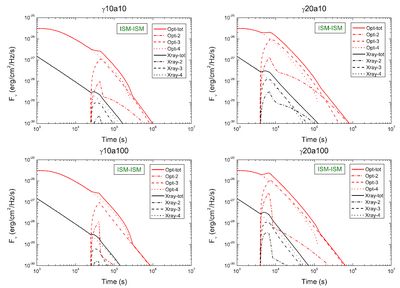|
|

|
 |
|
 |
|
|
 |
|
 |
 |
|
 |
|
| Revisiting the emission from relativistic blastwaves in a density-jump medium |
| Author: |
|
Update time: |
2014-09-28 |
Re-brightening bumps are frequently observed in gamma-ray burst afterglows. Many scenarios have been proposed to interpret the origin of these bumps, of which a blast wave encountering a density-jump in the circum-burst environment has been questioned by recent works. The interaction of the blast wave with the high-density medium is ascribed to two shocks: a reverse shock that propagates into the hot shell and a forward shock that propagates into the high-density medium. Thus the system consists of four separated regions: (1) unshocked high-density medium, (2) forward-shocked high-density medium, (3) reverse-shocked hot shell, and (4) unshocked hot shell. In this paper, the quantities (Lorentz factor, density, mass, internal energy, and pressure) of region “i” (regions 2, 3, and 4) are denoted by subscripts “i”, respectively. Recently Geng et al. (2014) developed a set of differential equations to calculate the relativistic outflow encountering the density-jump by extending the work of Huang et al. This approach is a semi-analytic method and is very convenient. This treatment has an advantage of global conservation of energy while the previous analytical results do not satisfy (e.g. Sari & Piran 1995; Kobayashi 2000; Wu et al. 2003; Zou et al. 2005). The results of Geng et al. (2014) show that late high-amplitude bumps cannot be produced under common conditions, rather only a short plateau may emerge even when the encounter occurs at an early time (<10 ks). In general, these results disfavor the density-jump origin for those observed bumps, which is consistent with the conclusion drawn from full hydrodynamics studies. The bumps thus should be caused by other scenarios. 
By with for WU Xuefeng Fig. 1.| Afterglow light curves for the four cases (e.g., ɤ10a100 corresponds to the case that when the blastwave encounters the density jump, the Lorentz factor of the blastwave is 10 and the density ratio is 100). The red lines and black lines are the optical band (4×10^14 Hz) andX-ray band (0.3 keV) light curves, respectively. The dotted lines (Opt-4 or Xray-4) represent the flux density of region 2 before the density-jump and the flux density of region 4 after the jump. The dashed lines (Opt-3 or Xray-3) are the contribution from region 3 after the density-jump. The dash-dotted lines (Opt-2 or Xray-2) mark the flux density of region 2 after the jump, and the solid lines (Opt-tot or Xray-tot) show the total flux density of all the components. A redshift z = 1 has been assumed. The work by Geng, J. J., Wu, X. F. (corresponding author), Li, L., Huang, Y. F., & Dai, Z. G., has been accepted to be published in the ApJ, please see ApJ, 792, 31 for more details (http://iopscience.iop.org/0004-637X/792/1/31/).
|
|
|
|
 |
|
 |
|
|
Copyright? Purple Mountain Observatory, CAS, No.10 Yuanhua Road, Qixia District, Nanjing 210023, China
Phone: 0086 25 8333 2000 Fax: 8333 2091 http://english.pmo.cas.cn |
|
|
